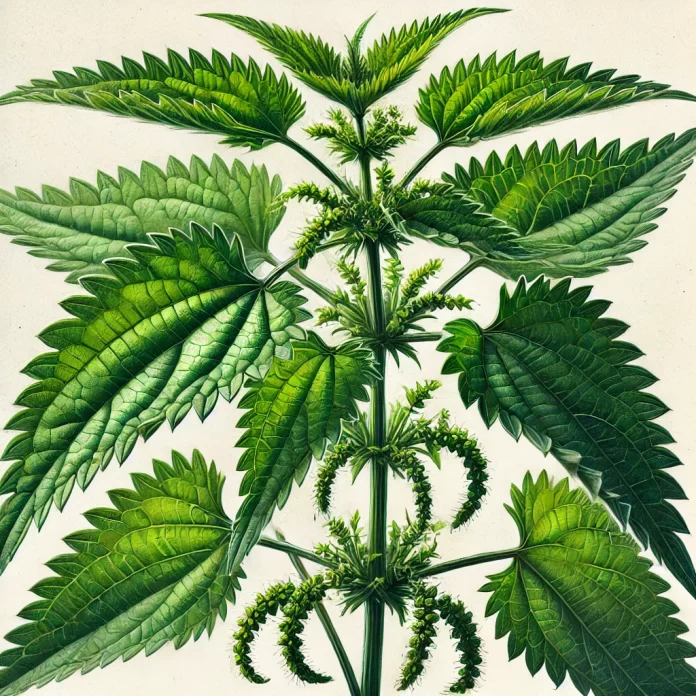Stinging nettles (Urtica dioica) are a common sight in gardens and wild areas, known for their distinctive serrated leaves and, as the name suggests, their irritating sting. While often considered a nuisance, these plants have both pros and cons. Let’s explore the multifaceted nature of stinging nettles, their uses, and strategies for managing them in your garden.
Wildlife Habitat:
Stinging nettles serve as a valuable habitat for various wildlife, including butterflies, moths, and certain caterpillars. Some species, like the Small Tortoiseshell butterfly, lay their eggs on nettles, making them essential for the life cycle of these insects.
Medicinal Properties:
Surprisingly, stinging nettles have medicinal benefits. They are rich in nutrients, including vitamins A and C, iron, and calcium. Nettle tea, made from the leaves, is believed to have anti-inflammatory properties and can be used to treat conditions like arthritis.
Making nettle tea is a simple process that allows you to enjoy the potential health benefits of nettles. Here’s a basic recipe to guide you:
Ingredients:
Fresh nettle leaves (harvested with gloves)
Water
Optional: Lemon, honey, or other flavorings for taste
Instructions:
Harvest Nettles:
Wear gloves to protect your hands from stings.
Harvest young, tender nettle leaves, preferably before the plant flowers.
Rinse the Leaves:
Thoroughly rinse the nettle leaves under cold, running water to remove any dirt or insects.
Prepare a Teapot or Infuser:
Place the nettle leaves into a teapot or a tea infuser.
Boil Water:
Bring water to a boil. The amount of water depends on how strong you want your tea.
Pour Hot Water Over Nettles:
Pour the boiling water over the nettle leaves in the teapot or infuser.
Steep:
Let the nettle leaves steep in the hot water for about 5 to 10 minutes. Steeping time can vary based on personal preference for strength.
Strain:
If using loose leaves, strain the tea to remove the nettle leaves. If you used an infuser, simply remove it from the teapot.
Flavoring (Optional):
Add lemon, honey, or other flavorings to enhance the taste. Adjust to your preference.
Serve and Enjoy:
Pour the nettle tea into cups and enjoy while it’s still warm.
Tips:
Experiment with Blends: Mix nettle leaves with other herbs like mint or chamomile for a unique flavor profile.
Drying Nettles: If you have an abundance of nettles, you can dry them for later use. Hang them upside down in a dark, well-ventilated area until they are completely dry.
Health Considerations:
Nettle tea is generally safe for most people, but if you have allergies or are pregnant, consult with a healthcare professional before consuming it regularly.
Drinking nettle tea is associated with various health benefits, including potential anti-inflammatory and diuretic effects.
Enjoy your nettle tea, and explore the diverse flavors and potential health perks this herbal infusion can offer!
Composting Material:
Nettles are excellent for composting. Their high nitrogen content accelerates the decomposition process, contributing to nutrient-rich compost that benefits your garden.
Natural Fertilizer:
Nettle tea, when used as a fertilizer, provides a nutrient boost to plants. Soaking nettles in water creates a liquid fertilizer that can enhance soil fertility and promote plant growth.
Nettle fertilizer, also known as nettle tea or nettle liquid fertilizer, is a nutrient-rich and cost-effective way to provide essential minerals and nutrients to your plants. Nettles are particularly beneficial as they contain nitrogen, potassium, and trace minerals. Here’s a simple guide on how to make nettle fertilizer:
Ingredients:
Fresh nettle leaves (harvested with gloves)
Water
Large bucket or container with a lid
Stirring stick or spoon
Optional: Gloves, as nettle leaves can cause skin irritation
Instructions:
Harvest Nettles:
Wear gloves to protect your hands from stings.
Harvest young, healthy nettle plants, preferably before they flower.
Prepare the Container:
Fill a large bucket or container with fresh nettle leaves. The container should have a lid to cover the mixture.
Add Water:
Pour water over the nettle leaves until they are fully submerged. Use rainwater or let tap water sit for a day to allow chlorine to dissipate.
Stir and Cover:
Stir the mixture well to ensure all leaves are wet.
Cover the container with a lid to keep out debris and insects.
Fermentation:
Let the mixture ferment for about 2 to 3 weeks. Stir the mixture every few days to promote the fermentation process.
You may notice a strong odor during fermentation; this is normal.
Strain:
After the fermentation period, strain the liquid to remove the solid plant material. You can use a fine mesh or cheesecloth for this purpose.
Dilute (Optional):
Dilute the strained liquid with water at a ratio of around 10:1 (water to nettle liquid) before using it on plants. This prevents the fertilizer from being too concentrated and potentially causing harm to plants.
Application:
Use the nettle fertilizer to water your plants or as a foliar spray.
Apply once every 2 to 4 weeks, depending on your plants’ needs.
Tips:
Nettle Leaf Use: You can also chop the nettle leaves and add them directly to the soil as a nutrient-rich mulch.
Additional Ingredients (Optional): Some gardeners add other ingredients such as comfrey leaves, seaweed, or eggshells for additional nutrients.
Caution:
Odor: The fermentation process can produce a strong odor. Consider placing the container in an area away from living spaces.
Wear Gloves: When handling nettles, especially during harvesting, wearing gloves is advisable to avoid skin irritation.
Making nettle fertilizer is an excellent way to utilize a natural resource and enhance your garden’s nutrient content.
Stinging Sensation:
The most notorious aspect of stinging nettles is, of course, their sting. Tiny hairs on the leaves and stems release irritating chemicals upon contact with the skin, causing a painful sensation. This can discourage outdoor activities and make gardening near nettles an unpleasant experience.
Aggressive Growth:
Nettles are robust and invasive, spreading rapidly through their rhizomes. Their aggressive growth can lead to the domination of garden spaces, outcompeting other plants and causing imbalances in the ecosystem.
Weed Competition:
In cultivated areas, stinging nettles often compete with desirable plants for resources, water, and sunlight. This can adversely affect the growth and health of neighboring plants.
Livestock Discomfort:
For those with livestock, stinging nettles can be problematic. The stinging hairs can cause discomfort to animals if they come into contact with the plants while grazing.
Managing Stinging Nettles:
Cultivate Carefully:
When growing other plants near stinging nettles, use barriers like mulch to discourage their spread. Regularly inspect and remove any nettles that appear to prevent them from becoming established.
Herbicides:
For more extensive infestations, selective herbicides can be used. Consult with local gardening experts or professionals to identify the most effective and environmentally friendly options.
Protective Gear:
When handling nettles, wear gloves and long sleeves to protect yourself from the stinging hairs. Promptly clean any exposed skin if contact occurs.
Harvest Responsibly:
If you choose to harvest nettles for medicinal or composting purposes, do so carefully. Use gloves and scissors, and avoid contact with exposed skin.
Encourage Predators:
Introduce or encourage natural predators like insects or small animals that feed on stinging nettles. This can help control their population naturally.
In conclusion, while stinging nettles can be a double-edged sword in your garden, understanding their pros and cons allows for informed decision-making. By employing strategic management practices, you can strike a balance that minimizes the negatives while harnessing the benefits that these resilient plants offer.




